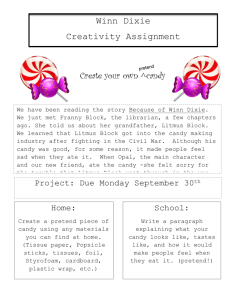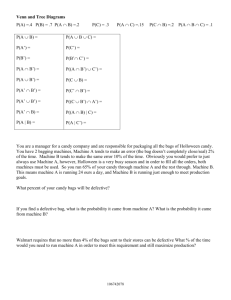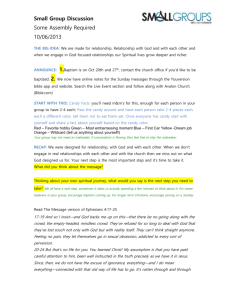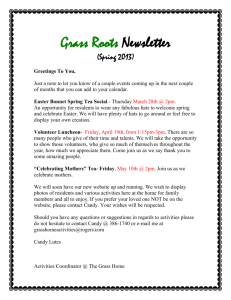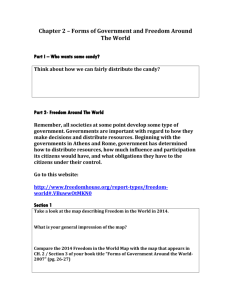Individual Lesson Plan Example
advertisement
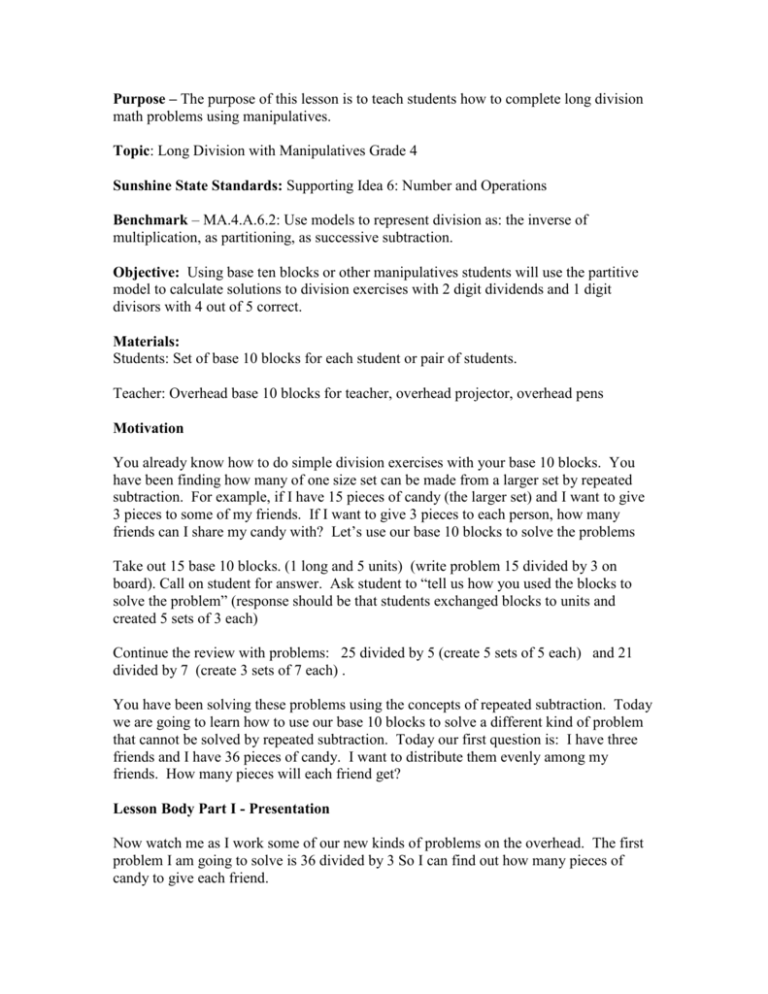
Purpose – The purpose of this lesson is to teach students how to complete long division math problems using manipulatives. Topic: Long Division with Manipulatives Grade 4 Sunshine State Standards: Supporting Idea 6: Number and Operations Benchmark – MA.4.A.6.2: Use models to represent division as: the inverse of multiplication, as partitioning, as successive subtraction. Objective: Using base ten blocks or other manipulatives students will use the partitive model to calculate solutions to division exercises with 2 digit dividends and 1 digit divisors with 4 out of 5 correct. Materials: Students: Set of base 10 blocks for each student or pair of students. Teacher: Overhead base 10 blocks for teacher, overhead projector, overhead pens Motivation You already know how to do simple division exercises with your base 10 blocks. You have been finding how many of one size set can be made from a larger set by repeated subtraction. For example, if I have 15 pieces of candy (the larger set) and I want to give 3 pieces to some of my friends. If I want to give 3 pieces to each person, how many friends can I share my candy with? Let’s use our base 10 blocks to solve the problems Take out 15 base 10 blocks. (1 long and 5 units) (write problem 15 divided by 3 on board). Call on student for answer. Ask student to “tell us how you used the blocks to solve the problem” (response should be that students exchanged blocks to units and created 5 sets of 3 each) Continue the review with problems: 25 divided by 5 (create 5 sets of 5 each) and 21 divided by 7 (create 3 sets of 7 each) . You have been solving these problems using the concepts of repeated subtraction. Today we are going to learn how to use our base 10 blocks to solve a different kind of problem that cannot be solved by repeated subtraction. Today our first question is: I have three friends and I have 36 pieces of candy. I want to distribute them evenly among my friends. How many pieces will each friend get? Lesson Body Part I - Presentation Now watch me as I work some of our new kinds of problems on the overhead. The first problem I am going to solve is 36 divided by 3 So I can find out how many pieces of candy to give each friend. First I take out 3 ten strips and 6 units and put them on my place holder sheet. Now, I have 3 friends so what I want to do is make 3 piles of blocks which will represent my candy. So I look at the 10’s place and I ask, can I take the strips and divide them into three piles. Yes I can. (show on overhead. Next I look at the units and ask, can I divide them evenly into 3 piles and add them to the piles I have created, Yes I can. (show on overhead) Now I count how many blocks I have in each pile. I have 12 in each pile. So 36 divided by 3 is 12. I can give each of my 3 friends 12 pieces of candy Let’s try another. This time we will see what happens if we want to share 45 pieces of candy among our 3 friends. (Write 45 divided by 3 on the board) First I lay out 4 ten strips (longs) and 5 units on my placeholder pad to represent the candy. Now I look at the tens place. Can I make three piles with the strips in the 10’s place? Lets try. (Lay out three piles of 1 ten strip each) I can make three piles, but I have a ten strip left. Can I divide this strip? Yes I can if I exchange it for 10 units. (Make the exchange) Now I have 15 units. Can I distribute them into three piles? Let’s see (do it). Now let’s count how many are in each pile. Each pile has 15. So 45 divided by 4 is 15 (write the answer as a quotient on the board). This time each of my 4 friends gets 15 pieces of candy. Here’s another problem. I want to have a birthday party and invite 4 friends. Mom bought a box of 96 party favors. How many can I give to each friend? First get out 9 longs and 6 units and lay them out on my place holder sheet. Look at the longs. Can I divide them into 4 groups? Response (yes put 2 in each group) How many longs do I have left? Response: (1) What should I do with the one that is left? (exchange for 10 units) Now how many units do I have after the exchange? Response (16) Can I distribute these into 4 groups? (yes 4 in each to make 24 in each group) Lesson body Part 2 Guided practice: Now I am going to ask you to help me solve the following problem: Suppose Mom bought 42 pencils for my brother and me to share. How many should each of us receive? Write 42 divided by 2 on board. Ask: “What is the first thing I should do?” Response: (Lay, 4 ten strips, and 2 units) Ask: “What should I do next?” Response: (See if you can divide the tens into two piles) Can I? (Yes) What do I do now? Response: (distribute the units into two piles). Can I? (Yes) Now I have distributed all the blocks. How do I know the solution to the problem. Response: (Count the blocks in each pile) How many are there? 21. Yes so 42 divided by 2 is 21 (write on board) Now use your base ten blocks to solve the following problem: 63 divided by 3 When students have worked problem, have one student come to front of room and use overhead blocks to solve the problem and explain what he or she is doing. Continue the practice with the following problems: 75 divided by 5; 88 divided by 8; 72 divided by 6. Now let’s draw a problem on the board and on your paper to show how we use our base ten blocks. 56 divided by 4 (Draw out problem on place holder model sheet) Have students tell you the steps to solve as you demonstrate). Draw 5 longs and 4 units. Draw 4 circles on the board to represent the 4 groups. As each long is distributed into a group, draw it in the circle and cross off one long on the place holder sheet. Cross off the left over long and draw 10 units. Then cross out each unit as it is distributed and drawn in the circles. If necessary continue with the following practice problems having students solve, draw and explain solutions 42 divided by 3, 50 divided by 5, 21 divided by 7, 96 divided by 8, Lesson Body Part III: Independent Practice Hand out worksheet with 10 word problems for students to solve using the partitioning model with base 10 blocks and drawings: (Attach worksheet to lesson plan.) Closure: Today you have learned how to use your manipulatives to solve division problems by distributing base ten blocks one place at a time starting with the tens place and then the ones. You have learned to make exchanges when you have tens left over that you cannot distribute evenly into established groups. This is called the partitive model of division. Tomorrow we will learn how to relate what we did today to solving problems using paper and pencil when we don’t have our base ten blocks. Extended Individual Practice: For homework you have these ten problems to practice solving using the partitive model. I want you to draw pictures of how you would distribute your base ten blocks for each solution. Worksheet with 10 problems for students to solve: Assessment: Give students 5 word problems to solve using base 10 blocks. Have students draw solutions they model with blocks. Example: Barbara’s mom gave her a bag of mini candy bars. She told Barbara she could share the candy with her 2 brothers. How many pieces of candy will each of the 3 children receive if there were 45 candy bars in the bag? Students must show the model of division by partitioning.

